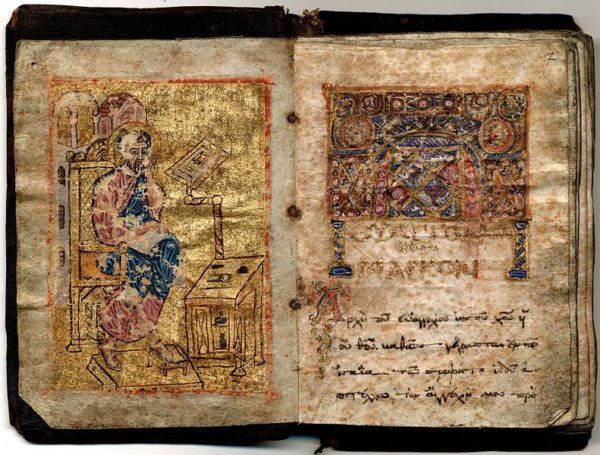

All ancient literature that we have in our possession today came from documents that were laboriously copied and recopied as they were passed down from one generation to the next. This includes the Bible. Even so, most people are not aware of how carefully the Bible has been passed down to us without error or modification. Without such understanding, it is easy to see how modern people believe that the biblical documents, being so ancient, have been dramatically changed or altered over the centuries.
In the mid 1400’s, Gutenberg invented the printing press, which radically changed the world. What most people do not know is that up until the time when the printing press was invented, there were only around thirty-thousand books that existed in all of Europe. And what’s interesting is that nearly all of these thirty-thousand works were Bibles or Bible commentaries meticulously recorded by monks over the centuries. How did this happen?
When you look back on the history of Rome, between the second and fifth centuries, the Roman Empire was in decline. Because of this decline Rome was highly vulnerable to attack by outsiders. In 395 A.D., the Roman Empire was split in to two separate entities. The Western Roman Empire and the Eastern Empire, which was called the Byzantine Empire. One hundred years later in the fifth century, the Barbarians invaded and left the Western Roman Empire in shambles.
In fact, it is hard to believe that this very civilized part of the Empire had completely disintegrated. Their cities were reduced to ruins and there was little left of Roman power, society, and culture. It just disappeared. And it triggered a five-hundred-year period that historians call the Dark Ages.
It’s hard to picture this part of the world, which had once been ruled by law and order—with such great intellectual pursuit and trade—merely disintegrating into a state of anarchy. It was during these Dark Ages, in this part of the world, when one could find no academic pursuits except for the work done by Christian monks in monasteries. And it was these monks who preserved the scriptures and much of the classical literature we have available today. Over time, Christian schools, libraries, and monasteries began to grow and flourish, particularly under the patronage of King Charlemagne from 768 to 814. It was during his reign that the Church was strengthened. Charlemagne placed intense effort on copying and preserving all of the ancient documents in their possession, and, since Christianity places such great emphasis on wisdom and knowledge, the Church’s preservation efforts to secure and copy new documents became its highest priority.
It’s interesting to note that ancient classical literature owes its survival today to Christianity and the Church. When we turn to the Byzantine Empire, we find a highly advanced multi-cultural society which for the most part remained Christian and existed for more than a thousand years. Christian scholars from this era and from this diverse culture not only preserved the Bible during these centuries, but also copied many of the secular Greek and Latin classics and much of the Jewish literature we have today.
A question I often encounter is how do we know that what we read in the Bible today conforms to the original documents when all we have are copies of the originals? Well, scholars who study ancient history will tell you that in order to test the validity of any ancient literary work you have to consider two criteria. (We will consider the first criteria in today’s blog, and the second in next week’s.) The first is to look at how many manuscripts exist (and when I say manuscripts, I’m talking about hand-written documents) that were copied prior to the printing press. So, you have to consider the number of ancient manuscripts we have in our hands today, manuscripts that you can look at and examine. The greater the number of manuscripts would indicate a greater accuracy of the writings in question.
Take Plato for instance. My closest friend from college was a political science professor for years and taught political philosophy. In one of his introductory courses he required his students to read Plato’s Republic. And he will tell you there is no scholar alive who questions the validity of that work. And yet, when you consider Plato, all we have is 7 manuscripts.
And take Aristotle, for example. We only have 49 of his manuscripts.
And Homer’s Iliad. We have 643 copies of his manuscripts.
But when you consider the New Testament, just the New Testament alone, we have 5,300 manuscripts written in the original Greek. We have over 10,000 Latin manuscripts of the entire New Testament, and we have 9,300 portions of the New Testament. In other words, we have over 24,000 manuscripts.
Now, you may ask, why is the number of manuscripts so significant? Dr. Bruce Metzger, a Greek New Testament scholar who taught at Princeton Theological Seminary and an authority on the ancient Greek manuscripts of the New Testament, says that when you have a large number of manuscripts from different geographical areas and different languages, you can cross check them to determine what the original documents were like. And he says, when you compare a manuscript that was copied in 300 A.D. with one that was copied in 900 A.D. you can determine if they are the same documents by a simple examination of the wording.
John Wenham, another Greek New Testament scholar and author of the highly regarded book, The Elements of New Testament Greek, says when you compare the great diversity of copies of New Testament manuscripts, you will find them all to be “relatively homogenous.” They appear to be almost the same, and this is why Metzger believes that the resulting text we have today is 99.5% accurate to the originals, and that that .5% in question does not affect a single doctrine.
And then Dr. Norman Geisler says this,
In fact, the New Testament documents have more manuscripts, earlier manuscripts, and more abundantly supported manuscripts than the best ten pieces of classical literature combined.
It seems to be quite clear that an overwhelmingly large number of New Testament manuscripts sufficiently demonstrates how fundamentally stable and accurate the reproduction of the biblical text was from the early first century to the invention of the printing press, a span of more than fourteen hundred years.
Much of this blog has been taken from my book, Reliable Truth: The Validity of the Bible in an Age of Skepticism. If you are interested in reading more, this book is available on Amazon.com and our website, www.thecenterbham.org.
Add grace and understanding to your day with words from Richard E. Simmons III in your inbox. Sign-up for weekly email with the latest blog post, podcast, and quote.

For local orders in the Birmingham, AL area, enter Promo Code LOCAL at checkout to save shipping. We will email you when your order is ready for pickup.
Bulk discounts for 25 or more books! Call 205-789-3471 for prices.